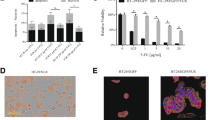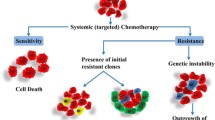Abstract
Doxorubicin, one of the clinically most useful anticancer agents, is used alone or in combination with other drugs against a wide variety of tumors, recently. But cancer cells developed resistance to this agent in many ways. This resistance is an important limiting factor of doxorubicin for anticancer drug. We newly established doxorubicin-resistant HCT15/CL02 subline from parental HCT15 human adenocarcinoma colon cancer cells. HCT15/CL02 revealed resistance to doxorubicin about 85-fold of its parental cells, and it also revealed cross-vealed to actinomycin D, etoposide and vinblastine but not to cisplatin and tamoxifen. And verapamil, a reversal agent of multidrug-resistance (MDR) by P-glycoprotein, elevated the cytotoxicity of doxorubicin against both HCT15 and HCT15/CL02 cells. But the relative resistant rate was not reduced. Verapamil had no effects on the toxicity of cisplatin to the both cell lines. These results indicate that HCT15/CL02 cells have some functionally complex mechanisms for MDR.
Similar content being viewed by others
References Cited
Abe, T., Hasegawa, S., Taniguchi, K., Yokomizo, A., Kuwano, T., Ono, M., Mori, T., Hori, S., Kohno, K. and Kuwano, M., Possible involvement of multidrug-resistance-associated protein (MRP) gene expression in spontaneous drug resistance to vincristine, etoposide and adriamycin in human glioma cells.Int. J. Cancer, 58, 860–864, (1994).
Awashi, S., Singhai, S. S., Srivastava, S. K., Zimniak, P., Bajpai, K. K., Saxena, M., Sharma, R., Ziller III, S. A., Frenkel, E. P., Singh, S. V., He, N. G. and Awashi, Y. C., Adenosin triphosphate-dependent transport of doxorubicin, daunomycin and vinblastine in human tissues by a mechanism distinct from the P-glycoprotein.J. Clin. Invest., 93, 958–965 (1994).
Bradley, G., Juranka, P. F. and Ling, V., Mechanism of multidrug resistance.Biochim. Biophys. Acta, 948, 87–128 (1988).
Callaghan, R., Zakher, G. and Epand, R., Increased accumulation of drugs in a multidrug resistant cell line by alteration of membrane biophysical properties.Biochim. Biophys. Acta, 1175, 277–282 (1993).
Chen, G., Jaffrzou, J. P., Fleming, W. H., Durn, G. E. and Sikic, B. I., Prevalence of multidrug resistance related to activation of themdr gene in human sarcoma mutants derived by single-step doxorubicin selection.Cancer Res., 54, 4980–4987 (1994).
Chen, G. L. and Liu, L. F., DNA topoisomerases: essential enzymes and lethal targets.Annu. Rev. Pharmacol. Toxicol., 34, 191–218 (1994).
Cole, S. P. C., Pinkoski, M. J., Bhardwaj, G. and Deeley, R. G., Elevated expression of Annexin II (Lipocortin II, p36) in a multidrug resistant small cell lung cancer cell line.Br. J. Cancer, 65, 498–502 (1992).
Cornwell, M. M., Gottesman, M. M. and Pastan, I. H., Increased vinblastine binding to membrane vesicles from multidrug-resistant KB cells.J. Biol. Chem., 261, 7921–7928 (1986).
Critchfield, J. W., Welsh, C. J., Phang, J. M. and Yeh, G. C., Modulation of adriamycin and efflux by flavonoids in HCT15 colon cells.Biochem. Pharmacol., 48, 1437–1445 (1994).
Damle, B. and Desai, P., Dipyridamole reverses the resistance to topoisomerase II inhibitors but not to antimicrotubule agents in multidrug-resistant melanoma cells.Oncol. Res., 6, 49–57 (1994).
Dimanche-Boitrel, M. T., Pelletier, H., Genne, P., Petit, J. M., Le Grimellec, C., Canal P., Ardiet, C., Bastian, G. and Chauffert, B., Confluence-dependent resistance in human colon cancer cells; role of reduced drug accumulation and low intrinsic chemosensitivity of resting cells.Int. J. Cancer, 50, 667–682 (1992).
Doyle, L. A., Ross, D. D., Sridhara, R., Fojo, A. T., Kaufmann, S. H., Lee, E. J. and Schiffer, C. A., Expression of a 95 kDa membrane protein is associated with low daunorubicin accumulation in leukaemic blast cells.Br. J. Cancer, 71, 52–58 (1995).
Eijdems, E. W. H. M., de Haas, M., Timmerman, A. J., Van der Sohans, G. P., Kamst, E., de Nooij, J., Astaldi Ricotti, G. C. B., Borst, P. and Baas, F., Reduced topoisomerase II activity in multidrug-resistant human non-small cell lung cancer cell lines.Br. J. Cancer, 71, 40–47 (1995).
Fojo, A. T., Ueda, K., Slaman, D. J., Poplack, D. G., Gottesman, M. M. and Pastan, I., Expression of a multidrug-resistance gene in human tumors and tissues.Proc. Natl. Acad. Sci. USA, 84, 265–269 (1987).
Fry, A., Chrest, C., Davies, S., Walker, C., Harris, A., Hartley, J., Masters, J. and Hickson, I., Relationship between topoisomerase II level and chemosensitivity in human tumor cell lines.Cancer Res., 51, 6592–6595 (1991).
Gheuens, E., van der Heyden, S., Elst, H., Eggermont, A., Oosterom, A. V. and De Bruijn E., Multidrug resistance in rat colon carcinoma cell lines CC531, CC531mdr+ and CC531rev.Jpn. J. Cancer Res., 84, 1201–1208 (1993).
Iwahashi, T., Okochi, E., Ono, K., Sugawara, I., Tsuruo, T. and Mori, S., Establishment of multidrug resistant human colorectal carcinoma HCT15 cell lines and their properties.Anticancer Res., 11, 1309–1312 (1991).
Juranka, P. F., Zastawny, R. L. and Ling, V., P-glycoprotein: multidrug-resistance and a superfamily of membrane-associated transport proteins.FASEB J., 3, 2583–2592 (1989).
Kartner, N., Riordan, J. R. and Ling, V., Cell surface P-glycoprotein associated with multidrug resistance in mammalian cell lines.Science, 221, 1285–1288 (1983).
Klohs, W.D. and Steinkampf, R. W., Possible link between the intrinsic drug resistance of colon tumors and a detoxification mechanism of interstinal cells.Cancer Res., 48, 3025–3030 (1988).
Kramer, R., Zakher, G. and Kim, J., Role of the glutathione redox cycle in acquired andde novo multidrug resistance.Science, 241, 694–697 (1988).
Lai, G. M., Chen, Y. N., Mickley, L. A., Fojo, A. T. and Bates, S. E., P-glycoprotein expression and schedule dependence of adriamycin cytotoxicity in human colon carcinoma.Int. J. Cancer, 49, 696–703 (1991a).
Lai, G. M., Moscow, J. A., Alvarez, M. G., Fojo, A. T. and Bates, S. E., Contribution of glutathione and glutathione-dependent enzymes in the reversal of adriamycin resistance in colon carcinoma cell lines.Int. J. Cancer., 49, 688–695 (1991b).
Lee, S. A., Karaszkiewicz, J. W. and Anderson, W. B., Elevated level of nuclear protein kinase C in multidrug-resistant MCF-7 human breast carcinoma cells.Cancer Res., 52, 3750–3759 (1992).
Lock, R. and Ross, W., DNA topoisomerases in cancer therapy. AnticancerDrug Des., 2, 151–164 (1987).
Mickley, L. A., Bates, S. E., Richert, N. D., Currier, S., Tanaka, S., Foss, F., Rosen, N. and Fojo, A. T., Modulation of the expression of a multidrug resistance gene (mdr-1/Pglycoprotein) by differentiating agents.J. Biol. Chem., 264, 18031–18040 (1989).
Naito, M. and Tsuruo, T., Competitive inhibition by verapamil of ATP-dependent high-affinity vincristine binding to the plasma membrane of multidrug-resistant K562 cells without calcium-ion involvement.Cancer Res., 49, 1452–1455 (1989).
Nitiss, J. L., Vilalta, P. M., Wu, H. and McMahon, J., Mutations in the gyrB domain of eukaryotic topoisomerase II can lead to partially dominant resistance to etoposide and amsacrine.Mol. Pharmacol., 46, 773–777 (1994).
Park, J. G., Lee, S. K., Hong, I. G., Kim, H. S., Lim, K. H., Choe, K. J., Kim, W. H., Kim, Y. I., Tsuruo, T. and Gottesman, M. M., MDR1 gene expression: its effects on drug resistance to doxorubicin in human hepatocellular carcinoma cell lines.J. Natl. Cancer Inst., 86, 700–705 (1994).
Ryu, S. Y., Choi, S. U., Lee, C. O. and Zee, O. P., Anticancer activity ofPsoralea corylifolia.Arch. Pharm. Res., 15, 356–359 (1992).
Skehan, P., Streng, R., SCudiero, D., Monks, A., McMahon, J., Vistica, D., Warren, J. T., Bokesch, H., Kenney, S. and Boyd, M.R., New colorimetric cytotoxicity assay for anticancer-drug screening.J. Natl. Cancer. Inst., 82, 1107–1112 (1990).
Tompkins, W. A. F., Watrach, A. M., Schmale, J. D., Schultz, R. M. and Harris, J. A., Cultural and antigenic properties of newly established cell strains derived from adenocarcinomas of the human colon and rectum.J. Natl. Cancer Inst., 52, 1101–1110 (1974).
Tsuruo, T., Reversal of acquired resistance to vinca alkaloids and anthracycline antibiotics.Cancer Treat. Rep., 67, 889–894 (1983).
Tsuruo, T., Iida, H., Tsukayoshi, S. and Sukarai, Y., Overcoming of vincristine-resistance in P388 leukemiain vivo andin vitro through enhanced cytotoxicity of vincristine and vinblastine by verapamil.Cancer Res., 41, 1967–1972 (1981).
Turner, M., Everman, D., Ellington, S. and Fields, C., Detection of free radicals during the cellular metabolism of adriamycin.Free Rad. Biol. Med., 9, 415–421 (1990).
Ueda, K., Cardarelli, C., Gottesman, M. M. and Pastan, I., Expression of a full-length cDNA for the human “MDR1” gene confers resistance to colchicine, doxorubicin and vinblastin.Proc. Natl. Acad. Sci. USA, 84, 3004–3008 (1987).
Wang, J. C., DNA topoisomerases.Annu. Rev. Biochem., 54, 665–697 (1985).
Weiss, R., Sarory, G., Clagett-Carr, K., Russo, M. and Leyland-Jones, B., Anthracycline analogues: the past, present, and future.Cancer Chemother. Pharmacol., 18, 185–197 (1986).
Zunino, F. and Capramco, G., DNA topoisomerase II as the primary target of anti-tumor anthracyclines.Anticancer Drug Des., 5, 30–52 (1990).
Author information
Authors and Affiliations
Rights and permissions
About this article
Cite this article
Choi, S.U., Kim, N.Y., Choi, E.J. et al. Establishment of doxorubicin-resistant subline derived from HCT15 human colorectal cancer cells. Arch. Pharm. Res. 19, 342–347 (1996). https://doi.org/10.1007/BF02976376
Received:
Issue Date:
DOI: https://doi.org/10.1007/BF02976376




